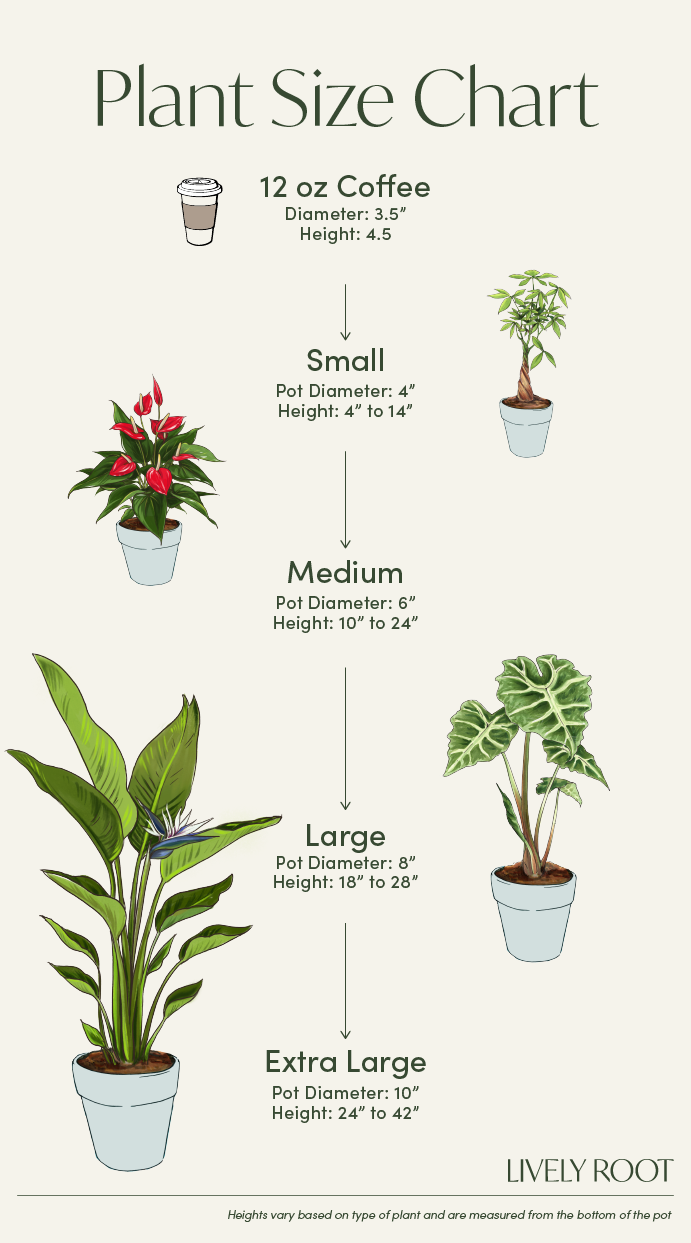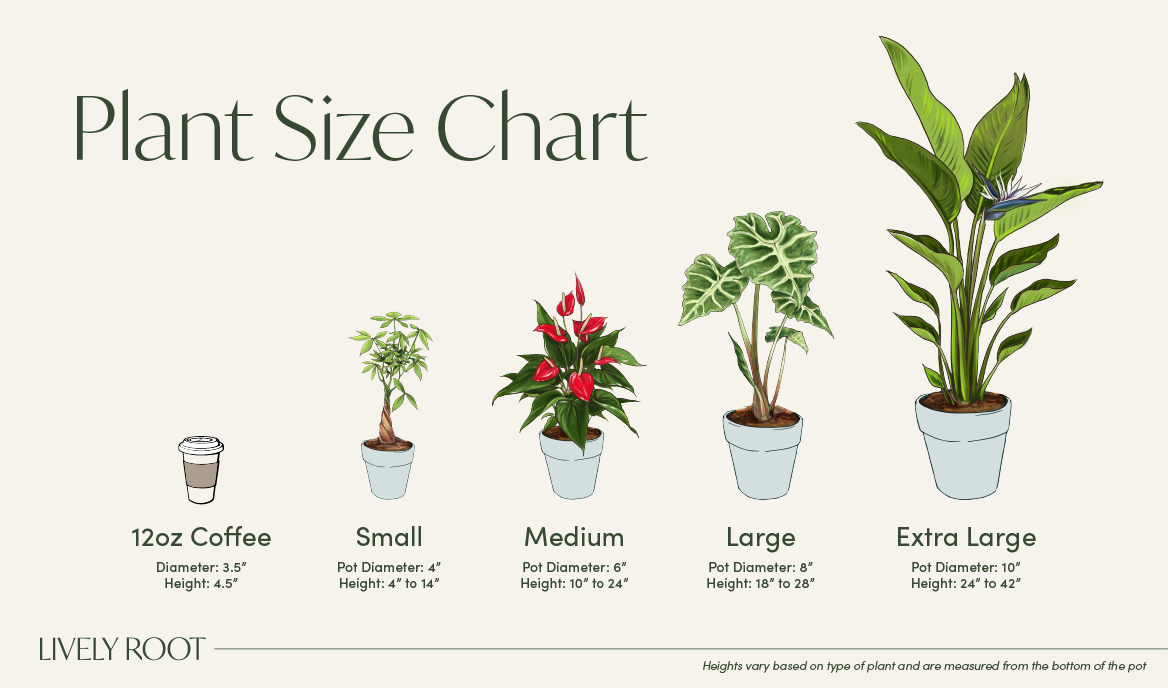

A popular houseplant for more than three hundred years, the lady palm (Rhapis Excelsa) instantly brings elegance into any room. They are one of our indoor and outdoor plants — they can grow happily on your patio if you live in USDA hardiness zones 8b through 12. They grow from multiple stems and have fan-shaped fronds, which give them a truly unique look. Not only are they beautiful, but they are also low maintenance too.
Lady Palm Care Guide & Presentation

Enjoys bright, indirect light.
Allow the soil to dry out completely between waterings. Keep the soil moist, but not soggy.
Enjoys some humidity. Spritz occasionally.
Keep in their ideal temperatures so that they will remain healthy.
Outside: Keep out of direct light as the rays will burn the leaves. Keep in full shade. Nightime temperatures need to remain above 55°F for healthy growth.
The Lady Palm doesn't need much fertilizer. Too much will harm the plant. Fertilize once a year in the spring. Use liquid fertilizer at half strength'Äîwater the plant before fertilizing.
When receiving the Lady Palm plant, do not repot immediately but wait at least 6-12 months. Repot in the spring, using a 2" bigger pot. (Too big of a pot could cause the soil to dry slower, which is not helpful.)
Try not to disturb the roots too much. These plants like to be a little root bound so don't go any bigger in pot size than recommended.
Place a piece of screening at the bottom of the container over the drainage hole to secure the soil and allow to drain. Use a well draining potting mix with perlite or an African Violet mix to help with drainage.
Lift the plant and release the roots against the existing planter. Use a clean knife or garden trowel to wedge between the pot and the soil to loosen.
Inspect the roots. Notice if there are any dead or rotting roots and trim off with sterile pruners.
Ensure the plant is sitting about 1 inch below the edge of the pot to avoid water spillage. Add more soil and backfill around the sides by tamping down. Fill up to the soil line but not over.
Water thoroughly, leaving the soil damp but not soggy. If settling occurs, add more soil.
Water well to dampen the soil and let drain.
As new leaves form, lower leaves will discolor and die off. Use sterile pruners and cut off the aging leaves. If tips of the leaves are browning, trim the ends off to help the plant regain strength. Remove any debris from the soil and replenish if needed. To clean debris and dust off the leaves:
Place the palm in a shower or tub.
Fill a watering can with a shower spout with filtered, bottled, or water free of chlorine and fluoride.
Shower the leaves, so each one is clear of dust and dirt.
Let the water drain and replace your palm in the decorative container.
Remove a 6-8 inch cutting from the mother plant. Place the stem in water and replace every week. Once stem grows at least two inches of roots, poke a hole in damp soil and place the stem. Mix into the soil some rooting hormone. Cover the cutting with a clear, plastic bag and mist. Check soil moisture periodically. Within six weeks, the roots should be getting established. Place in bright to medium, indirect light and follow care instructions.
Lady Palm: Overview
The Lady Palm, scientifically known as Rhapis excelsa, is a graceful and elegant plant known for its slender, upright stems and lush, fan-shaped foliage. Belonging to the family Arecadeae, this beautiful palm is native to Southern China and Taiwan. It thrives in hardy plant zones 9 to 11 and is characterized by its long lifespan when provided with proper care. While not particularly sun-loving, lady palms are adaptable and can tolerate low-light conditions. They have an easy-care nature and make a wonderful addition to any indoor space. Moreover, lady palms are perfect for households with pets, as they’re not toxic to animals.
Rhapis Excelsa: Alternative Names
- Lady Palm
- Ground Rattan
- Bamboo Palm
- Miniature Fan Palm
- Fern Rhapis
- Broadleaf Lady Palm
Lady Palm: Benefits
- Excellent air purifier, removing carbon dioxide, carbon monoxide, allergens, and other toxins from your living space
- Boosts your mental health
- Humidifies your home
- Non-toxic to pets
- One of the easiest plants to own
- Hardy and almost impossible to kill
- Adds a tropical vibe to your home
Lady Palm Care Guide
The lady palm plant is relatively low-maintenance, making it suitable for beginners and busy plant owners. See below its growing and care requirements.
Watering and Light
The lady palm tree prefers evenly moist soil but can tolerate occasional drying out between waterings. Water thoroughly when the top inch of soil feels dry, and ensure proper drainage to prevent root rot.
These plants thrive in bright, indirect light. However, they also tolerate lower light conditions. Avoid direct sunlight, as it may scorch the leaves.
Temperature and Humidity
The Rhapis palm prefers temperatures between 65-80°F (18-27°C) and is sensitive to cold drafts. Protect it from sudden temperature drops, especially during the winter.
While they can adapt to average indoor humidity levels, lady palms appreciate slightly higher humidity. Regular misting or placing a humidity tray nearby can help maintain adequate moisture levels.
Soil, Repotting, and Feeding
Repot your lady palm every 2-3 years or when it outgrows its current container. Spring is the best time for repotting and encouraging healthy growth.
Use a well-draining, peat-based potting mix for your lady palm and ensure the pot has drainage holes to prevent waterlogging.
Fertilize every 2-3 months during the growing season with a balanced liquid fertilizer diluted to half strength.
Propagation
Lady palms are typically propagated by dividing the root ball during repotting. Each division should have several healthy stems and roots. Use this opportunity to share a lady palm as a gift with friends and family.
Pruning, Cleaning, and Common Issues
Remove any yellowing or dead leaves regularly to maintain the plant’s appearance and overall health. Wipe the leaves with a damp cloth periodically to remove dust and keep them looking glossy and vibrant.
Lady palms are pest-resistant, but insects like spider mites or scale may affect these large plants. Treat any infestations promptly with neem oil or insecticidal soap.
With their elegant fronds and adaptable nature, lady palms make an excellent addition to any indoor space. Whether you’re a seasoned plant enthusiast or just starting your indoor gardening journey, these versatile plants offer beauty and benefits.
Best Locations & Uses
- Lady Palms are non-toxic to cats and dogs, making them safe additions to homes with furry friends.
- With their low-maintenance nature and tolerance for various light conditions, lady palms are perfect for those new to indoor gardening.
- Their air-purifying qualities and calming presence make them ideal for enhancing the ambiance of office spaces or creating a relaxing atmosphere in bedrooms.
- Due to their impressive size and striking foliage, the lady palm can be a stunning focal point in larger rooms or open living areas.
- Lady Palms thrive in warm, humid conditions, making them an excellent porch plant in regions with mild climates.
Companion Plants
Enjoy the beauty of your lady palm with these complementary green companions:
- Peace Lily (Spathiphyllum spp.): The Peace Lily's elegant white blooms and lush foliage pair perfectly with the graceful fronds of the Lady Palm, creating a serene and harmonious indoor oasis.
- Neanthe Bella Palm (Chamaedorea elegans): With its compact size and feathery leaves, the Neanthe Bella Palm complements the lady palm's tropical aesthetic, adding a touch of greenery to your home.
- Calathea Orbifolia Plant (Calathea orbifolia): Featuring striking striped leaves and a unique pattern, the Calathea Orbifolia adds visual interest and texture to any indoor plant collection, harmonizing beautifully with the elegant foliage of the lady palm.
Alternative Plants
Looking for alternatives to the lady palm? Check out these beauties available here on Lively Root.
- Areca Palm (Dypsis lutescens): With its graceful fronds and air-purifying qualities, the Areca Palm offers a tropical ambiance similar to the lady palm, making it an excellent choice for indoor greenery enthusiasts.
- Cat Palm (Chamaedorea cataractarum): Resembling the lady palm in its resilience and elegant appearance, the Cat Palm adds a charming touch to any space with its feathery fronds.
- Coconut Palm (Cocos nucifera): Bringing a taste of the tropics indoors, the Coconut Palm is a pet-friendly plant, which features striking foliage and a slender trunk reminiscent of the lady palm. It is a bold statement piece for larger spaces.
Get You High-Quality Lady Palm from LivelyRoot Today!
Are you ready to enhance your indoor space with the elegance of the lady palm? Shop now and bring the beauty of nature into your home today!






























